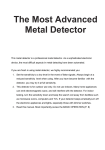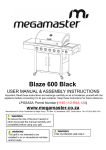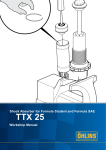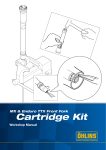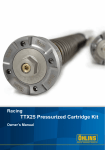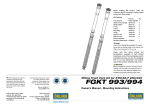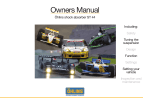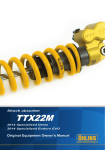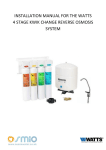Download Work shop manual
Transcript
Work shop manual Öhlins front fork ø 43 Road & Track Including: Introduction Safety instructions Dismantling the front fork Change of seals and bushings Dismantling the cartridge Assembling the fork leg 1 Before installation Safety signals Important information concerning safety is distinguished in this manual by the following notations: The Safety alert symbol means: Caution! Your safety is involved. Öhlins Racing AB can not be held responsible for any damage whatsoever to shock absorber or vehicle, or injury to persons, if the instructions for fitting and maintenance are not followed exactly. Similarly, the warranty will become null and void if the instructions are not adhered to. WARNING! WARNING! Failure to follow warning instructions could result in severe or fatal injury to anyone working with, inspecting or using the suspension, or to bystanders. CAUTION! Caution indicates that special precautions must be taken to avoid damage to the suspension. NOTE! This indicates information that is of importance with regard to procedures. 1. Installing a shock absorber, that is not approved by the vehicle manufacturer, may affect the stability of your vehicle. Öhlins Racing AB cannot be held responsible for any personal injury or damage whatsoever that may occur after fitting the shock absorber. Contact an Öhlins dealer or other qualified person for advice. 2. Please study and make certain that you fully understand all the mounting instructions and the owners manuals before handling this shock absorber kit. If you have any questions regarding proper installation procedures, contact an Öhlins dealer or other qualified person. 3. The vehicle service manual must be referred to when installing the Öhlins shock absorber Öhlins products are subject to continual improvement and development. Consequently, although these instructions include the most up-to-date information available at the time of printing, there may be minor differences between your suspension and this manual. Please consult your Öhlins dealer if you have any questions with regard to the contents of the manual. NOTE! During storage and transportation, especially at high ambient temperature, the oil and grease used for assembling may run out inside the packing and damage the expanded polystyrene packing material. This is not unusual and is in no way detrimental to the shock absorber. Contents Dismantling the fork ______________________________ 3 Change of seals and bushings _____________________ 5 Dismantling the cartridge __________________________ 7 Removal and fitting of the inner tube ________________8 Assembling the cartridge __________________________ 9 Assembling the fork leg _________________________ 10 Maintenance and inspection _____________________ 11 © Öhlins Racing AB. All rights reserved. Any reprinting or unauthorized use without the written permission of Öhlins Racing AB is prohibited. Printed in Sweden. 2 Dismantling the fork 1 Remove the front fork legs from the motorcycle. 1 2 2 Fasten the fork leg in a vice. Use soft jaws. 3 17 mm wrench 3 Loosen the spring pre-load by turning the upper adjustment nut counter clock vise. Use a 17 mm wrench. 24 mm socket Top nut tool 0797-04 4 Loosen the top nut assembly. Use Top nut tool (797-04) 4 3 5 17 mm wrench Let the outer tube drop down. Use Top nut holder (4705-01) or a 17 mm wrench to keep a firm hold of the cartridge nut. 5 CAUTION! Beware not to damage the O-ring. NOTE! Tool 4705-01 or 17 mm wrench When a standard 17 mm wrench is used, the upper spring seat must be pressed down, to make access to the nut. 6 6 Use a 17 mm wrench to loosen the top nut and remove the top nut assy from the cartridge. 7 Unscrew and remove the upper nut of the shaft to release the upper spring seat and the pre load tube. 8 Use a steel wire shaped to a hook in one end to grip the spring and pull the spring out. 9 Remove the pre-load tube. 7 10 Upper nut Free the front fork from the vice and pour the front fork fluid out. Upper spring nut The adjustment rod must be held in position not to fall out. NOTE! 11 Put the front fork leg back into the vice and carefully slide the outer tube upwards to remove it. Spring NOTE! Use a cloth to avoid excess oil from trickling out from the tube. Pre-load tube 9 10 8 Steel wire with hook Spring 4 Change of seals and bushings 1 Dust seal Tool 4705-01 Remove the dust seals with a flat tool, i.e. the other side of the top nut holder (4705-01). Use a piece of cloth under the tool to prevent it from damaging the end of the outer tube. 1 2 Use a small flat tip screwdriver to remove the oil seal clip. 3 Remove the oil seal in the same way the dust seal was removed. Remove the seat washer beneath the seal. Oil seal clip 4 Use a heat gun to warm up the outer tube to a temperature of approximately 100°C. Remove the bushings. This is made with the use of attachment bar (1757-01), dismantling sleeve (1759-07) and a hammer. The tool is inserted from the bottom of the tube. 2 4 Attachment bar 1757-01 Oil seal Heat gun 3 Seat washer Dismantling sleeve 1259-07 5 5 Clean the outer tube carefully and reinstall the bushings. Use attachment bar (1757-01), installing sleeve (1759-08) and guide ring (1758-04). Attachment bar 1757-01 5 CAUTION! Be careful to get the bushings straight and do not push the upper bushing too far down into the tube, as that can cause malfunction. Heat the tube before the bushings are installed. Use a heat gun. Put the outer tube back onto the inner tube and check the function to make sure that the bushings are installed in a correct way. Guide ring 1758-04 NOTE! Apply locking fluid Loctite 601 or similar to the outside of the bushings before installing them into the outer tube. Installing sleeve 1759-04 6 Reinstall the seat washer under the oil seal. Apply some grease (147-01) to the outside of the oil seal. This makes it much easier for the seal to slide into the tube. Use guide ring (1758-04) to push it into correct position. Oil seal CAUTION! Seat washer Be careful not to apply grease into the sealing surface. 6 Dust seal 7 7 Circlip Outer tube Outer tube 6 Put the circlip back and press the dust seal back into position. Apply grease (147-01) onto the outside of the seal before installation. Use fingers only. Dismantling the cartridge 1 Loosen the cartridge and pull it out. Use Cartridge tool (4702-01) Pour the fluid out. Empty by sliding the piston rod in and out. 1 2 Free the fork bottom and inner tube from the vice and pour the remaining oil out. Cartridge tool 4702-01 2 3 Use clamping tool (787-03) and reinstall the cartridge into the vice. The clamping tool should be close to the base valve. Approximately 20 mm from the cartridge end. Cartridge 4 Use cartridge tool (04702-01) to loosen the spring seat cap from the cartridge tube. As the cap is fixed with locking fluid a heat air gun must be used to release it. Inner tube 20 mm Clamping tool 0787-03 3 4 Piston shaft 6 Cartridge tool 04702-01 5 Base valve Clamping tool 0787-03 7 5 Use clamping tool (787-03) and refit the cartridge into a vice. The clamping tool should be positioned so that the base valve is free. 6 Use a small, flat tip screwdriver to loosen the base (compression) valve. Pull the base valve out with a rotating movement, not to damage the o-rings. 7 Pull the piston shaft out from the cartridge tube. Take care not damage seals and surfaces. Clean the parts carefully. Cartridge tube NOTE! Use compressed air to remove excess fluid and particles and to dry the parts. 7 Nut Piston holder 8 9 Collar Remove the rebound valve from the piston rod. Disassemble the rebound valve by removing the nut, washers, piston and the shims. 9 Spring Disassemble the base (compression valve) in a similar way. Shim When disassembling the rebound and compression valves it is necessary to put the components on the working bench in correct order to avoid mistakes in assembly work Spring Shim 8 NOTE! Piston Piston O-ring Shims Shims Removal and fitting of the inner tube Collar Collar Bolt NOTE! This procedure is normally only performed when the inner tube or the fork bottom has been damaged and has to be replaced. Nut Rebound valve Base valve 1 Fasten the inner tube to the vice. 2 Remove the inner tube from the fork bottom. Use of clamp tool (786-05) and a heat air gun to release the fork bottom from locking fluid. Clamping tool 0786-05 Clamp tool 0786-05 2 3 200 Nm 1 3 Refit the inner tube to the fork bottom. Use Loctite 270 or similar and tighten to a torque of approximately 200 Nm. 4 When reinstalling the inner tube to the fork bottom, locking fluid Loctite 270 or similar must be used. 8 Assembling the cartridge 1 Clean all parts of the base valve and rebound valve carefully and assemble them in correct order. Tighten the nuts to correct torque: 8 Nm. 20 mm 2 Put a new O-ring onto the compression piston. Reinstall the base (compression) valve into the cartridge case. Use grease (147-01) and push it into position with a rotating movement, to avoid damaging the o-ring. 3 3 Use clamping tool (787-03) and put the cartridge tube back into the vice. The clamp tool should be positioned around the base valve seat. 4 Put a new piston ring onto the rebound piston. Apply grease (147-01) to the valve and push the piston rod into the cartridge case. 5 4 Apply some Loctite 270 or similar to the spring seat cap. Screw the spring seat cap (seal head) back. Use cartridge tool (4702-01) and tighten it to 40 Nm. CAUTION! It is of great importance to use a torque wrench. Spring seat 5 Cartridge tube Cartridge tool 04702-01 6 Insert the cartridge tube into the inner tube. Apply some grease (147-01) to the tread going into the fork bottom and tightenit to a torque of 40 Nm. Use a torque wrench. 6 Cartridge tool 4702-01 Inner tube 40 Nm Outer tube 9 Assembling the fork leg 1 Apply front fork fluid onto the inner tube and reinstall the outer tube. 1 2 Fill 500 ml Öhlins front fork oil (1309-01)into the inner tube. Push the piston rod up and down until the cartridge is completely filled with oil. NOTE! Open the compression adjuster fully before pumping procedure. Use a 3 mm allen tool 3 Reinstall the adjustment rod and the pre-load tube. 4 Measure the oil level and adjust to correct level (see Mounting instructions for correct data). See Owners manual Oil level 500 ml oil 1309-01 2 Pre-load tube Adjustment rod 10 3 4 5 Reinstall the spring, the upper spring seat and the nut of the piston rod. Nut NOTE! Upper spring seat The spring is to be positioned with the marking number facing upward. 6 Pull the piston rod upwards and screw it into the top nut assy. Use Top nut holder (4705-01) or a 17 mm wrench to keep a firm hold of the cartridge nut and use a 17 mm wrench to tighten to a torque of 20 Nm. 5 Spring 17 mm wrench 6 4705-01 or 17 mm wrench 7 Put the top nut assy back into the fork leg. Use top nut tool (797-04) and tighten it gently by hand. 8 7 Adjust compression and rebound by first turning the adjusters clock vise to 0-position. Then turn them counter clock vise to correct number of clicks according to Mounting instructions or Specification card. Set the pre-load according to specifications. 9 Reinstall the fork legs to the motorcycle. 9 Inspection and maintenance For optimal performance: Racing Street use 50 hours (hard riding, shorter intervals) 10,000 km 11 More info www.ohlins.com Öhlins Racing AB, Box 722, S-194 27 Upplands Väsby, Sweden Phone +46 8 590 025 00, Fax +46 8 590 025 80 12 07640-02, Teknisk Illustration, WSM 05 03. The ultimate suspension site. Find out everything about your suspension. Download mounting instructions, manuals and brochures. And a lot more.












